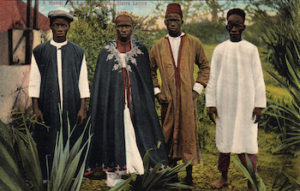
*The Mandé community is celebrated on this date in c 300. They are Black African speakers of Mandé languages. Descended from ancient central Saharan people, the Mandé constitute an identifiable language family with associated peoples spread throughout West Africa.
Prehistory
Mandé peoples were early producers of woven textiles through a process known as strip weaving. The Mandé have been credited with the independent development of agriculture from about 3,000–4,000 BC. This agricultural base stimulated the development of some of the earliest and most complex civilizations of Western Africa. They founded the Ghana and Mali Empires and led the expansion of the Songhai Empire across West Africa. Archaeological evidence shows that the Mandé were early producers of stone settlement civilizations. These were built in Southern Mauritania, beginning around 2,000 BC and 1,500 BC, by ancient Mandé, likely early Soninke, peoples. Hundreds of stone masonry settlements with clear street layouts have been found in this area. Some settlements had massive defensive walls, while others were less fortified.
The population grew in a now arid environment where arable land and pasture were once at a premium. Relatively large-scale political organizations emerged, leading to the development of military hierarchical aristocracies. The agro-pastoral society had a mixed farming economy of millet production and raising livestock. They also worked with copper. They traded in jewelry and semi-precious stones from distant parts of the Sahara and Sahel. They are believed to be the first to domesticate African rice. An archaeologist described their ancient, abandoned sites as representing "a great wealth of rather spectacular prehistoric ruins." Mande people created a series of early cities and towns, also related to the Soninke, along the middle Niger River in Mali, including Dia, beginning from around 900 BC, and later at Djenné-Djenno comprised an urban complex consisting of 40 mounds within a 4-kilometer radius.

Arts
Much Mandé art is in the form of jewelry and carvings. The masks associated with the fraternal and sorority associations of the Marka and the Mendé are probably the best-known and finely crafted in the region. The Mandé people also produce beautifully woven fabrics, which are popular throughout western Africa. The bells on the necklaces are believed to be heard by spirits, ringing in both worlds, that of the ancestors and the living. Mandé hunters often wear a single bell, which can be quickly silenced when stealth is necessary.
On the other hand, women often wear multiple bells, representing concepts of the community since the bells ring harmoniously together. Djenné-Djenno is famous for its terracotta figurines, which depict humans and animals, including snakes and horses, some dating to the first millennium and early second millennium AD. It is believed that these figurines served a ritual function, and it is hypothesized that some are representations of household or ancestral spirits, as ancestral cults are known to have flourished in the area as late as the 20th century.
Music
The best-known type of traditional Mandé music is played on the kora, a stringed instrument with 21 or more strings mainly associated with the Mandinka people. It is performed by families of musicians known in Mandinka as Jeliw or French as griots. The N'goni is the ancestor of the modern banjo and is played by jelis. Griots are professional bards in northern West Africa, keepers of their great oral epic traditions and history. They are trusted and powerful advisors of Mandé leaders. Toumani Diabate, Mamadou Diabate, and Kandia Kouyaté are among the most celebrated today. The Mandé languages are divided into two primary groups: East Mandé and West Mandé. They have various cuisines, cultures, and beliefs and are organized mainly by their language group.
Today, they are predominantly Muslim and follow a caste system. Islam has played a central role in identifying the Mandé as a supranational ethnic group transcending individual tribal affiliations. The Mandé conducted increased trade down the River Niger or overland and achieved military conquest with the expansion of the Wassoulou states. Mandé groups are found in Benin, Burkina Faso, Côte d'Ivoire, Gambia, Ghana, Guinea, Guinea-Bissau, Liberia, Mali, Mauritania, Niger, Nigeria, Senegal, and Sierra Leone. The non-Mande-speaking Fula, Songhai, Wolof, Hausa, and Voltaic peoples maintain varying degrees of close alignment with the Mandé worldview, clothing, and other cultural artifacts (a shared written script, architecture, cuisine, and social norms).